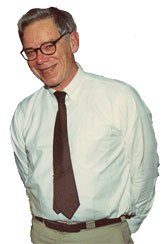People
Ignatius G. Mattingly, Ph.D.
In Memoriam
Nov. 22, 1927 - Mar. 5, 2004
Emeritus Senior Scientist, Haskins Laboratories
Member, Board of Directors, Haskins Laboratories
Emeritus Professor, University of Connecticut
Ignatius Mattingly was a prominent linguist and speech scientist. Prior to his academic career, he was an analyst for the National Security Agency from 1955 to 1966. He was a Lecturer and then Professor of Linguistics at the University of Connecticut from 1966 to 1996 and a researcher at Haskins Laboratories from 1966 until his death in 2004. He is best known for his pioneering work on speech synthesis and reading and for his theoretical work on the motor theory of speech perception in conjunction with Alvin Liberman.
Mattingly, working with British collaborators, John N. Holmes and J. N. Shearme, adapted the Haskins pattern playback rules to write the first computer program for synthesizing continuous speech from a phonetically spelled input. A further step toward a reading machine for the blind combined Mattingly's program with an automatic look-up procedure for converting alphabetic text into strings of phonetic symbols. In the 1960s he also produced the first prosodic synthesis by rule.
Education
1947, B.A., Yale University, English (Honors)
1959, M.A., Harvard University, Linguistics
1968, Ph.D., Yale University, English
Experience
1972-1996, Professor of Linguistics, University of Connecticut
1968-72, Associate Professor of Linguistics, University of Connecticut
1967-68, Lecturer in Linguistics, University of Connecticut
1966-67, Lecturer in English, University of Connecticut
1966-2004, Research Staff Member, Haskins Laboratories
1963-64, Guest Researcher, Joint Speech Research Unit, Eastcote, U. K.
1951-66, Analyst, National Security Agency
1950-51, Instructor in English, Yale University
1947-48, Instructor in English, Groton School
Honors
Member, Technical Committee on Speech Communication, Acoustical Society of America, 1966-72
Fulbright Research Fellowship, University of Cambridge, England, 1970-1971
Fellow, King’s College, Cambridge, England, 1970-1971
Fellow, Acoustical Society of America, 1983-
Member, Editorial Board, Journal of Phonetics, 1995-
Research Interests
Speech synthesis; speech perception; the reading process
Selected Publications
Mattingly, I. G. (1966). Synthesis by rule of prosodic features. Language and Speech, 9, 1-13.
Mattingly, I. G., Liberman, A. M., Syrdal, A. K., & Halwes, T. (1971). Discrimination in speech and nonspeech modes. Cognitive Psychology, 2, 131-157.
Mattingly, I. G. (1972). Reading, the linguistic process, and linguistic awareness. In J. F. Kavanagh & I. G. Mattingly (Eds.), Language by ear and by eye: The relationships between speech and reading.(pp. 133-147). Cambridge, MA: MIT Press.
Mattingly, I. G. (1972). Speech cues and sign stimuli. American Scientist, 60, 327-337.
Mattingly, I. G. (1974). Speech synthesis for phonetic and phonological models. In Thomas A. Sebeok (Ed.), Current Trends in Linguistics, Volume 12, Mouton, The Hague, pp. 2451–2487.
Erickson, D., Mattingly, I. G., & Turvey, M. T. (1977). Phonetic activity in reading: An experiment with Kanji. Language and Speech, 20, 384-403.
Liberman, A. M. & Mattingly, I. G. (1985). The motor theory of speech perception revised. Cognition, 21, 1-36.
Mattingly, I. G. (1990). The global character of phonetic gestures. Journal of Phonetics, 18, 445-452.
Mattingly, I. G. (1991). In Defense of the Motor Theory, Implications for Speech Motor Control. Paper from the symposium Current Phonetic Research Paradigms:.Stockholm, Sweden, August 13-16, 1991, pp. 167-172.
Mattingly, I. G. (1991). Modularity, Working Memory, and Reading Disability. In S. A. Brady and D. Shankweiler (Eds.), Phonological Processes in Literacy, Erlbaum, pp. 163-171.
Mattingly, I. G. (1991). Reading and the biological function of linguistic representation. In I. G. Mattingly & M. Studdert-Kennedy (Eds.), Modularity and the Motor Theory of Speech Perception (pp. 339-346). Hillsdale, NJ: Lawrence Erlbaum.
Mattingly, I. G. (1992). Linguistic Awareness and Orthographic Form. In R. Frost and L. Katz (Eds.), Orthography, Phonology, Morphology, and Meaning, Elsevier Science Publishers, B.V, pp. 11-26
Mattingly, I. G. (1994). Horizontal and vertical views of Chinese psycholinguistics. Advances in the Study of Chinese Language Processing, Vol. 1 pp. 541-547.
Mattingly, I. G. (1998). Why did coarticulation evolve? Behavioral and Brain Sciences, Vol. 21 pp. 275-276
Mattingly, I.G. (1999). A short history of acoustic phonetics in the U.S Proceedings of the XIVth International Congress of Phonetic Sciences, San Francisco, CA, pp. 1-6
Books
Kavanagh, J. F. & Mattingly, I. G. (Eds.). (1972). Language by ear and by eye: The relationships between speech and reading.(pp. 133-147). Cambridge, MA: MIT Press.
Mattingly, I. G. & Studdert-Kennedy, M. (Eds.). (1991). Modularity and the Motor Theory of Speech Perception (pp. 339-346). Hillsdale, NJ: Lawrence Erlbaum.

